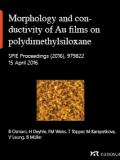J. Vis. Exp. (136), e56967 (2018)
Lee, I. N., Hosford, J., Wang, S., Hunt, J. A., Curran, J. M., Heath, W. P., Wong, L. S.
Scanning probe microscopy has enabled the creation of a variety of methods for the constructive ('additive') top-down fabrication of nanometer-scale features. Historically, a major drawback of scanning probe lithography has been the intrinsically low throughput of single probe systems. This has been tackled by the use of arrays of multiple probes to enable increased nanolithography throughput. In order to implement such parallelized nanolithography, the accurate alignment of probe arrays with the substrate surface is vital, so that all probes make contact with the surface simultaneously when lithographic patterning begins. This protocol describes the utilization of polymer pen lithography to produce nanometer-scale features over centimeter-sized areas, facilitated by the use of an algorithm for the rapid, accurate, and automated alignment of probe arrays. Here, nanolithography of thiols on gold substrates demonstrates the generation of features with high uniformity. These patterns are then functionalized with fibronectin for use in the context of surface-directed cell morphology studies.
This technique can also be used for detection of DNA, see Polymers 2019, 11, 561.




